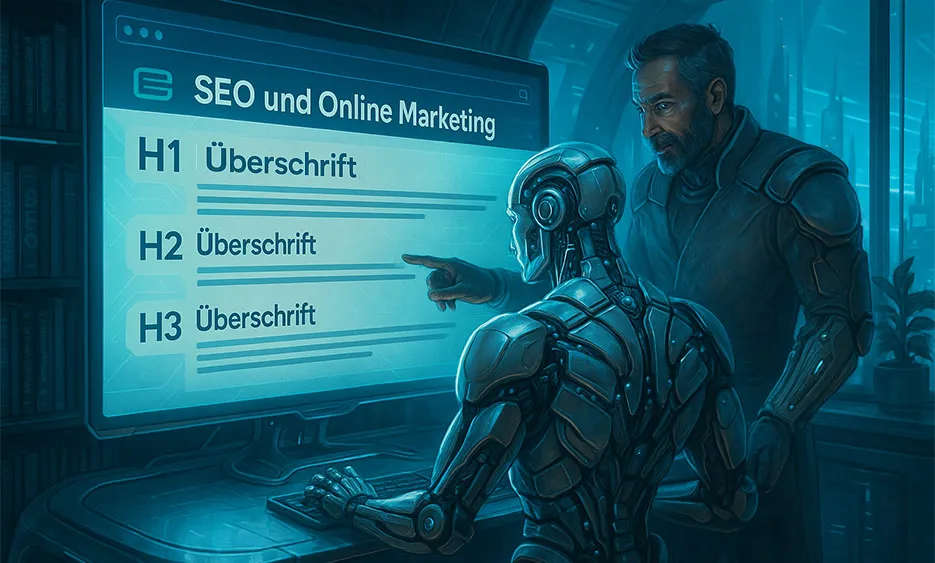
LLMs & SEO: Why H headings are crucial
12. June 2025
In online marketing, search engine optimization (SEO) is becoming increasingly important. Technical details such as the correct use of H-headings are moving more and more into focus. This is especially true in the age of large language models (LLMs) like ChatGPT or Gemini. For a full-service agency specializing in online marketing, email marketing, and performance marketing, it is essential to use these structures optimally. This way, you address both users and search engines as well as AI systems effectively.
In this article, we explain why H-headings play a key role in SEO today. We also show you how to structure your content clearly with them. This way, you strengthen your online presence sustainably.
Why are H headings so important in online marketing?
H-headings (heading tags) structure content on a website and create clear outlines. In the past, they were mainly used for visual formatting. Today, however, they primarily serve a content-related purpose. They help search engines and large language models better understand and analyze texts. This way, they can specifically filter out relevant answers.
A clean heading structure improves readability and usability. These two factors directly lead to higher conversion rates in performance marketing. In addition, well-placed H-tags make it possible to integrate relevant keywords in prominent positions. This significantly increases the visibility of your content.
What mistakes should be avoided?
Despite the importance of H headings, many websites contain frequent errors:
- Multiple H1 tags on one page, which confuses search engines.
- H tags in the footer or other unimportant areas.
- Use of H tags for purely visual design rather than semantic structuring.
- Lack of clear structure, which makes it difficult to chunk content.
These mistakes reduce the performance of your website in online marketing. They also make it harder for modern AI models to understand your content.
How do H-headings help large language models (LLMs) such as ChatGPT with analysis?
Large language models are increasingly analyzing websites. They highlight relevant text passages in search results or quote them directly. A clear and logical heading structure is crucial here:
What is chunking and why is it important?
Chunking describes the breakdown of large amounts of text into smaller, manageable sections. H1 to H3 are ideal for structuring content:
- H1 defines the main topic of a page and should be unique.
- H2 marks key topic sections.
- H3 subdivides details or answers specific questions.
This structure enables AI to accurately identify which section provides which information. This is a basic requirement for snippet generation and intelligent search result display.
Why are questions preferred in headlines?
Search engines and LLMs prefer questions in H2 or H3 tags because they directly reflect user intent. Headings like “How does SEO with H-headings work?” or “Why are H-tags important for performance marketing?” often appear as featured snippets. Therefore, they significantly increase the click-through rate.
How do I use H headings correctly for my SEO strategy?
A well-thought-out heading structure optimizes your online marketing easily and efficiently. Here are our key recommendations:
How many H1 tags can a page have?
You should use only one H1 tag per page. It clearly defines the main topic and ideally contains the most important keyword, for example, “Online marketing with a focus on SEO and performance marketing.”
What is the function of H2 and H3 tags?
- H2 structures the main sections and highlights different aspects of the topic, for example, “Importance of H-headings in email marketing.”
- H3 summarizes specific questions or subpoints, such as “How does a clear H-structure improve the user experience?”
Should keywords be included in headings?
Yes, of course, and it makes sense to integrate main and secondary keywords into headings. This prevents the text from sounding artificial. This increases relevance for search engines and at the same time offers readers a clear benefit.
Why not use H tags outside of the main content?
Headings should only be used to structure the main content. H-tags in the footer, navigation, or for CTAs confuse search engines. This reduces content clarity.
Practical example: Improved SEO through optimized heading structure
A client in the field of email marketing suffered from poor visibility, even though the content was high quality. Our analysis revealed an unclear H-tag structure with multiple H1 tags and mixed headings. We implemented the following measures:
- Clear assignment of a single H1 tag with relevant main keyword.
- Structure the content with precise H2 and H3 tags.
- Inclusion of questions in H2/H3 that addressed frequently asked questions from users.
- Natural integration of keywords into headings.
The result: Within six weeks, the rankings increased significantly. In addition, organic visibility measurably improved, and the user engagement rates improved considerably.
Conclusion
Companies that want to succeed in online marketing, performance marketing, or email marketing today need well-structured H-headings. These help search engines and LLMs optimally understand content and better serve relevant search queries.
As a full-service agency, we provide you with comprehensive consulting. We help you prepare your website both technically and in terms of content, so you achieve better rankings and more traffic in the long term.
Would you like to make your website SEO-ready and improve your online marketing strategy? Feel free to contact us today.
Our blog
Latest news
With our blog, you are always close to our work, our current projects and the latest trends and developments in web and print.
Any questions?





